The selection of dispersants should be based on the characteristics of the pigments to be dispersed and the performance requirements of the coating. Dispersants have a great influence on the particle size distribution, tinting strength, stability, gloss and defects of pigments. The dispersing ability of dispersants is mainly evaluated from the following aspects: viscosity reduction and viscosity stability, particle size distribution of pigment slurry, Tinting strength, color development, hue, covering rate, flocculation, gloss, surface defects, bubbling effects, compatibility with resins and additives, storage stability, etc.
Each pigment has an optimal concentration value in a specific dispersion system. This optimal value is related to the specific surface area of the pigment, oil absorption, final required fineness, grinding time and the characteristics of the resin polymer used in the color paste; it must be determined based on these conditions and the equipment and process must be adjusted during the experiment. factors are taken into consideration. Generally speaking, inorganic pigments use anionic dispersants with relatively low molecular weight and high polarity, and the addition amount is 1% to 5% of the pigment content; for organic pigments, considering the specific surface area, it is best to use polymer nonionic wetting for organic pigments. The final addition of dispersant needs to be determined by the addition amount and viscosity reduction curve.

